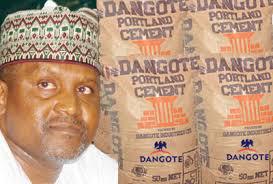
In a bid to gain supremacy in the African cement market, the richest man on the continent announced the construction of cement plants in 11 countries of the continent.
Nigerian billionaire Aliko Dangote, the richest man in the Africa according to the Forbes’ list, has signed up with a Chinese construction company for the project. This I being viewed as a direct challenge to international cement manufacturers Lafarge, the largest cement company in Africa.
Analysts perceive this move by Dangote as well timed as the continent in headed for an infrastructure boom.
The challenges however ahead of Dangote are posed by the world’s biggest cement maker, a flood of low-priced imports, the threat of slowing growth in contracts for dams, ports and roads and a slump in the most-traded emerging-market currencies to a record low.
“Africa’s future growth is intrinsically linked to cement,” Dangote, 58, told assembled dignitaries, including Zambian President Edgar Lungu, earlier this month as he opened a new factory on the outskirts of Ndola, Zambia’s third-largest city. The material is “the most basic input into building infrastructure,” he said.
The new plant would increase the total production capacity of the Dangote Cement Plc to 43 million tons by the end of this year which is very close to the highest production capacity of the market leader LafargeHolcim Ltd. Interestingly, LafargeHolcim’s largest cement plant is situated just 30 kilometres away from the latest plant of Dangote Cement.
Dagonte was reported to having said that his company intends to double the present maximum production capacity to about 80 million tons. In an expansion spree, the company has already has expanded its capacity five-fold in the last four years.
Dangote Cement has plans to open four more plants by the end of the year and the Ndola plant is just one of the five new factories. Two of the factories would be opened in Cameroon and Zambia, thought to the strongholds of LafargeHolcim.
The rapid growth of some of the economies in Africa has made the once poor continent into one of the emerging economic regions. The world’s fastest growing region is also witnessing an increasing demand for building material as rapid urbanization and spending on transport, power and shipping boost demand.
The largest of the infrastructure projects include Ethiopia’s $4 billion hydro-power dam on the Blue Nile River and a $13 billion railway that will link the Kenyan port of Mombasa to the Rwandan capital of Kigali via Uganda.
The largest cement producer in Africa is LafargeHolcim, a joint venture of Lafarge, with a production capacity of 50 million tons a year of cement. Apart from the presence of big players like Lafarge, domestic manufacturers like Dagonte also have to contend with cheap imports from countries including Pakistan.
“Dangote is rapidly expanding its footprint across sub-Saharan Africa. Many of the cement plants within the region are old and aging. Their efficiency has fallen, so with its new plants it will be able to compete strongly,” said Pabina Yinkere, head of research at Lagos-based Vetiva Capital Management Ltd.
(source:www.forbes.com)
Nigerian billionaire Aliko Dangote, the richest man in the Africa according to the Forbes’ list, has signed up with a Chinese construction company for the project. This I being viewed as a direct challenge to international cement manufacturers Lafarge, the largest cement company in Africa.
Analysts perceive this move by Dangote as well timed as the continent in headed for an infrastructure boom.
The challenges however ahead of Dangote are posed by the world’s biggest cement maker, a flood of low-priced imports, the threat of slowing growth in contracts for dams, ports and roads and a slump in the most-traded emerging-market currencies to a record low.
“Africa’s future growth is intrinsically linked to cement,” Dangote, 58, told assembled dignitaries, including Zambian President Edgar Lungu, earlier this month as he opened a new factory on the outskirts of Ndola, Zambia’s third-largest city. The material is “the most basic input into building infrastructure,” he said.
The new plant would increase the total production capacity of the Dangote Cement Plc to 43 million tons by the end of this year which is very close to the highest production capacity of the market leader LafargeHolcim Ltd. Interestingly, LafargeHolcim’s largest cement plant is situated just 30 kilometres away from the latest plant of Dangote Cement.
Dagonte was reported to having said that his company intends to double the present maximum production capacity to about 80 million tons. In an expansion spree, the company has already has expanded its capacity five-fold in the last four years.
Dangote Cement has plans to open four more plants by the end of the year and the Ndola plant is just one of the five new factories. Two of the factories would be opened in Cameroon and Zambia, thought to the strongholds of LafargeHolcim.
The rapid growth of some of the economies in Africa has made the once poor continent into one of the emerging economic regions. The world’s fastest growing region is also witnessing an increasing demand for building material as rapid urbanization and spending on transport, power and shipping boost demand.
The largest of the infrastructure projects include Ethiopia’s $4 billion hydro-power dam on the Blue Nile River and a $13 billion railway that will link the Kenyan port of Mombasa to the Rwandan capital of Kigali via Uganda.
The largest cement producer in Africa is LafargeHolcim, a joint venture of Lafarge, with a production capacity of 50 million tons a year of cement. Apart from the presence of big players like Lafarge, domestic manufacturers like Dagonte also have to contend with cheap imports from countries including Pakistan.
“Dangote is rapidly expanding its footprint across sub-Saharan Africa. Many of the cement plants within the region are old and aging. Their efficiency has fallen, so with its new plants it will be able to compete strongly,” said Pabina Yinkere, head of research at Lagos-based Vetiva Capital Management Ltd.
(source:www.forbes.com)





